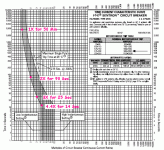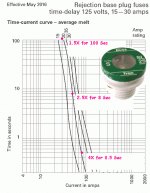Am getting prepared to install a triamped active speaker audio system and wondering how people have handled the electrical service. I plan to use 3 two channel amps (hypex nc1200 for the bass, and 2 purifi amps- one each for mid and treble). I will also need service for a Octo 8 channel dac and a computer/streamer. Seems I will need 3 20 amp circuits and 1 15 amp circuit in theory. What have others done? Thanks.
I have a quad amp'ed system on one 20A circuit. And those are all AB amps 200W for bass/mid bass and 100w for mid-tweet/tweet. I think the amps you mentioned are D, which are much more power efficient. I do soft-start and time delay on power up though. Lights dim otherwise.
Seems you have a total of 700 watts. A 20A circuit should handle twice that without an issue. I will have a total of 1400 watts for the nc1200's, 1700 watts for the 4 purifi modules alone, totaling 3100 watts. That's at least 2 15 amp circuits, plus another for the streamer and dac. Probably safe to just put each amp into its own circuit...
Class D nears 100% efficiency, AB is only around 50%. And it is 4X200(bass/mid-bass) + 4X100(mid-tweet/tweet) audio available or 1200W of audio. So around 2400W of pull of AC could happen. In practice nothing even close. But really can your tweeters handle the full power of the purifi, or even your mids? Probably the only thing close to pulling full power will be the bottom. I've never been close to full power on any of the elements in a normal sized living room.Seems you have a total of 700 watts. A 20A circuit should handle twice that without an issue. I will have a total of 1400 watts for the nc1200's, 1700 watts for the 4 purifi modules alone, totaling 3100 watts. That's at least 2 15 amp circuits, plus another for the streamer and dac. Probably safe to just put each amp into its own circuit...
If you put that power into the lf drivers upon turning them on (we all turn on our power amps while signal is applied and the volume control is at -0dB, right???) the rattle created might rip the power lines apart or burn the voice coils. Problem solved.
Sorry for the sarcasm. Straight answer: Don't worry about it, you will never draw close to 20A to power that said system.
Sorry for the sarcasm. Straight answer: Don't worry about it, you will never draw close to 20A to power that said system.
The manual for my Rane 6 X 100W amp says it's capable of tripping a 15A service. That would be an AB design. 20A, I assume it could output 100W on all 6 channels continuously - which would never happen with each channel driving a 3 way speaker.
Edit; Unh, I mean each channel independently driving individual drivers in two 3-way speakers...
Edit; Unh, I mean each channel independently driving individual drivers in two 3-way speakers...
Last edited:
But will you play FULL power ALL the time?totaling 3100 watts
Even if you do, you may not go to heavy clipping. Marginally un-clipped speech/music typically averages 10%-15% of clipping level. While class B is lossy at that level, class D will be near 15% of your 3,100 Watts or under 500 Watts.
Even if you set peaks right AT clipping, I pull 5,500 Watts off a 15A 125V feed dozens of times a day. My well pump takes 44 Amps to start. The lights dim (my wire to the street is long) but there's no actual strain. (No heat, no sparks.)
But will you play FULL power ALL the time?
Even if you do, you may not go to heavy clipping. Marginally un-clipped speech/music typically averages 10%-15% of clipping level. While class B is lossy at that level, class D will be near 15% of your 3,100 Watts or under 500 Watts.
Even if you set peaks right AT clipping, I pull 5,500 Watts off a 15A 125V feed dozens of times a day. My well pump takes 44 Amps to start. The lights dim (my wire to the street is long) but there's no actual strain. (No heat, no sparks.)
As an engineer we are trained to design with a factor of safety and for worse case scenarios- habits are hard to break, lol.
For the several years we ran a tri-amped rig in local clubs, I'm sure we never had more than one single 20 or 25A circuit(*) feeding 2 Bryston 4B's, a McIntosh 2300, and a Bryston 2B, 3 channels of Moog parametric, a Urei 527-A, a diy crossover (250, 1600Hz), a diy 6-channel mixer, and an early-model, basic Tapco 6-channel mixer. Clip lights tickled by the last set in every venue, much earlier in most. No compressors; no limiters (yeah, we were foolish). All Class AB amps; no Power Factor Correction; capable of 2400W at clipping. Never popped a single breaker or fuse. But we did make a point of running the lights on a separate circuit, whenever possible.
With no compression or limiting, the ratio of Peak, to minute-to-minute RMS, was a lot higher than it would be today -- especially with processed sources.
If you can forgive my rudeness, maybe track down a fast-reacting power meter -- some of the best I've seen were on a vintage Yamaha amp -- and sit with it for a while playing familiar music. Or if you have the rig set up for testing, feed it some pink noise 'til the compressors/clip lights flicker; pretty sure you'll want to stay out of range, or maybe the room, it'll be that loud. And the RMS power drain will be much lower than you'd expect. 😉
Oh, and Thanks PRR -- your perspective is much valued.
Cheers
* I know it was a single circuit because I ran the whole rig from one custom 10-3 power cable plugged into one outlet
With no compression or limiting, the ratio of Peak, to minute-to-minute RMS, was a lot higher than it would be today -- especially with processed sources.
If you can forgive my rudeness, maybe track down a fast-reacting power meter -- some of the best I've seen were on a vintage Yamaha amp -- and sit with it for a while playing familiar music. Or if you have the rig set up for testing, feed it some pink noise 'til the compressors/clip lights flicker; pretty sure you'll want to stay out of range, or maybe the room, it'll be that loud. And the RMS power drain will be much lower than you'd expect. 😉
Oh, and Thanks PRR -- your perspective is much valued.
Cheers
* I know it was a single circuit because I ran the whole rig from one custom 10-3 power cable plugged into one outlet
Yeah, they told Sprague he could not start multiple electric streetcars on one track.As an engineer we are trained to design with a factor of safety and for worse case scenarios- habits are hard to break, lol.
The analysis must be time-based. In the UK they figure amps seconds squared. In the US, UL gives us generously ample safety factors. (Frank lacked advance theory, so probably just noted that one streetcar start hardly warmed the wire, and cruise heat was negligible, so he started a bunch of streetcars one after the other.)
I've melted enough wires and fuses to understand that that short-term overload is OK, and you can push it too far. I know you can hang 13 old Macintoshes on a 1930s schoolroom circuit, the 14th pops the breaker. (We needed 20- I rigged a Rick-like custom splitter from an unused stove outlet.)
Someone has been pruning my music files. Nothing normal?? FWIW, the Dead's Feedback from Live Dead, normalized, has a passage at -8dB RMS over 50mS. But I can't stay in the room with that track on today's weak drugs.
James Rhodes Live in Brighton, In the Hall of the Mountain King, last 30 seconds "becomes increasingly loud and frenetic." James Rhodes is a rocker of classic piano.

As my well-pump shows, you can't melt a line fuse (much less line wire) in anything like 50mS (my analyst's default). In fact power wires at mild overload will hold-in for minutes. Fuses for the purpose will hold for many minutes at twice rated current (and we used to test this curve with 2 to 3 tea-pots in adjacent offices).
So I scanned for max RMS over 5 seconds. The value seems to be -11.1dB or 0.28 of voltage, 0.078 (8%) of power. 0dB @ 3100W, this is 240 Watts. Under 270W including class D losses.
Hey, the full 3100W at 120V is "only" 25 Amps. That's even legal for #12 wire-- but over time this would cook some older devices (receptacles). But you would not enjoy 3100W steady tone.
What will really burn-up first is your voice coils. Unwind a burnt woofer and compare to #12 wall-wire. Yes the impedances are different but not vastly.
Ah-ha. I thought I had stuff more interesting than piano. Here is Hamburger Totentanz, an oddly compelling work for pipe organ, on a sweet little organ in a stone church and a very simple recording rig. IIRC, zero limiting, I only normalized-out my safety margin. (Even clipped a bit, I see; I bet my working WAV was clean and the MP3 process put a few peaks over.)

Whether 50mS or 60,000mS (a minute, let the heat build), the max RMS runs -7dB. Which is 640 Watts on your rig.
Whether 50mS or 60,000mS (a minute, let the heat build), the max RMS runs -7dB. Which is 640 Watts on your rig.
A common residential circuit breaker is rated for 3 hour continuous current. It can handle 10 times that current for a good fraction of a second.
So unless you are running long full volume test tones, a single circuit can handle several big power amps playing music or movies.
But it may require turning the big amps on, one at a time.
So unless you are running long full volume test tones, a single circuit can handle several big power amps playing music or movies.
But it may require turning the big amps on, one at a time.
I'm not finding time-current curves for my residential breakers.common residential circuit breaker is
I find a plot for 70A-250A molded breakers, and the wide range suggests that smaller models will be similar, they just don't publish them.

These breakers are "adjustable" for short-term overload. Yes, 10X overload for 10 seconds or 4.4X for 14 seconds, engineer's choice.
3X for 25 to 150 seconds. 2X for 90 to 600 seconds. These are very long musical crescendos.
Since I did not find actual data for 15A-20A domestic breakers I turned back the clock to fuses. Although widely frowned-upon by insurance, I still have fuses in the garage. That data (there's effectively only one brand) is easy to find.

These medium-duty fuses melt faster than the breakers. (The ST series holds longer for large long-hard-start motors; wood-chippers etc). 2X overload for 40 seconds, 4X overload for a half second (still longer than a rim-shot or piano attack). And correctly picked fuses are well-proven to be safe for even fragile domestic wiring. (Insurance distrust because classically you could use an up-size fuse or a penny to restore service; this particular part requires a permanent adapter for the design current.)
- Home
- General Interest
- Everything Else
- Electrical service for triamped active speaker systems